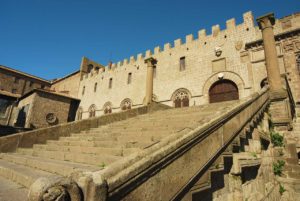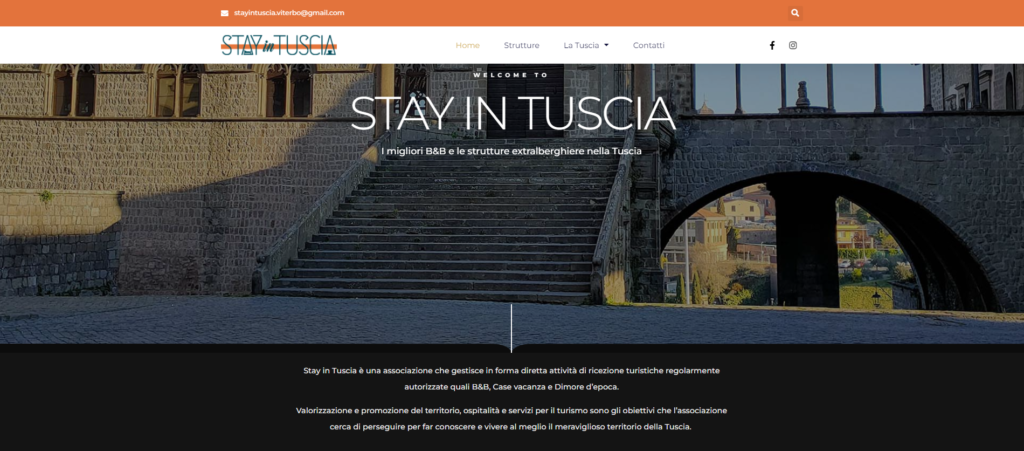STOREP 2022: Accommodation and social activities
[:en]
Economics and the Economic System: The Ecological Transition
19th STOREP Annual Conference
Università della Tuscia, Viterbo, 26-28 May 2022
II Home ΙΙ Registration ΙΙ Invited Speakers ΙΙ Raffaelli Lecture ΙΙ INET-STOREP Initiative ΙΙ
ΙΙ Young Scholars ΙΙ General and Session Program – Special session @ Polo Universitario di Civitavecchia II
II Numbers and areas II Venue II Accommodation and social activities II
* * *
Accommodation
STAY IN VITERBO, STAY IN TUSCIA
Stay in Tuscia is an association that manages directly B&Bs, holiday homes and similar.
A warm and professional welcome and quality services will make your experience in Viterbo unforgettable.
This is our contribution to the enhancement and promotion of our territory.
To discover all the best accommodation facilities visit www.stayintuscia.com (NB The website is in Italian, but the English version is under preparation. Non-Italian speakers can contact Stay in Tuscia in Engish at stayintuscia.viterbo@gmail.com for purposes of finding accommodation).
You can also find us on Facebook and Instagram.
Complete the experience in Viterbo by discovering its beauties: www.viterbopass.it.
Social activities
Viterbo – Papal Palace and more (Saturday, May 28, 2022)
History of Viterbo
Viterbo, the capital of Tuscia, welcomes visitors with its imposing city walls that completely enclose it. It is about four kilometres long and was built from 1095 onwards, to protect itself from threats from Rome.
Viterbo had become a free city-state and conquered the entire area of the present province, establishing itself over the various centres of Tuscia. The city alternated between Guelph factions (represented in particular by the Gatti family) and Ghibelline factions (led by the Di Vico family).
After the siege of 1243 by Emperor Frederick II and the city’s resistance to the imperial forces, the Guelph side prevailed for a few years. This dominance was put into action with the construction of the Papal Palace (1255-1267) and the transfer of the papal seat to the city.
The Palace of the Popes also hosted the first and longest conclave in history, when the term that currently defines the election of popes was invented. In the Conclave Hall the cardinal electors were in fact confined (clausi cum clave as the Latin text says) and later the palace was made “discooperto”, i.e. deprived of its roof. After the period of papal dominance, which ended in 1284, the city returned to its normal condition of a free council defined mostly, by the tensions between families that characterised this institution.
Moreover, in the mid-1200s, the redevelopment of Piazza del Plebiscito began, becoming the heart of the city’s political power. Palazzo dei Priori was the last of the buildings constructed in the square.
 The creation of the various pictorial cycles decorating the rooms of the Palace began at the end of the 15th century and continued for over a century, retracing the myth and history of the city of Viterbo and its illustrious men.
The creation of the various pictorial cycles decorating the rooms of the Palace began at the end of the 15th century and continued for over a century, retracing the myth and history of the city of Viterbo and its illustrious men.
The end of the free city-state era for Viterbo was sanctioned by the conquest by Cardinal Egidio Albornoz, who prepared the ground for the Pope’s return from Avignon. Unlike other municipalities that evolved into lordships, Viterbo became part of the Patrimony of San Pietro in Tuscia.
WHAT TO SEE
– Meeting with the guide at the rectory UNITUS or at Porta Romana
– Visit to the Palazzo dei Priori (Priori’s Palace)
– Visit to the Palazzo dei Papi (Papal Palace)
– Visit to the medieval area of San Pellegrino, where the palaces of the noble families of Viterbo are to this day preserved (Di Vico, Gatti, Alessandri, Cocco etc.).
CONTACT: info@museocolledelduomo.com
NB: Participants are required to pay 15 EUR per person for the Tour directly at the Conference desk. The tour starts at 3pm and runs for 3 hours.
Economics and the Economic System: The Ecological Transition
19th STOREP Annual Conference
Università della Tuscia, Viterbo, 26-28 May 2022
II Home ΙΙ Registration ΙΙ Invited Speakers ΙΙ Raffaelli Lecture ΙΙ INET-STOREP Initiative ΙΙ
ΙΙ Young Scholars ΙΙ General and Session Program – Special session @ Polo Universitario di Civitavecchia II
II Numbers and areas II Venue II Accommodation and social activities II
* * *
Accommodation
STAY IN VITERBO, STAY IN TUSCIA
Stay in Tuscia is an association that manages directly B&Bs, holiday homes and similar.
A warm and professional welcome and quality services will make your experience in Viterbo unforgettable.
This is our contribution to the enhancement and promotion of our territory.
To discover all the best accommodation facilities visit www.stayintuscia.com (NB The website is in Italian, but the English version is under preparation. Non-Italian speakers can contact Stay in Tuscia in Engish at stayintuscia.viterbo@gmail.com for purposes of finding accommodation).
You can also find us on Facebook and Instagram.
Complete the experience in Viterbo by discovering its beauties: www.viterbopass.it.
Social activities
Viterbo – Papal Palace and more (Saturday, May 28, 2022)
History of Viterbo
Viterbo, the capital of Tuscia, welcomes visitors with its imposing city walls that completely enclose it. It is about four kilometres long and was built from 1095 onwards, to protect itself from threats from Rome.
Viterbo had become a free city-state and conquered the entire area of the present province, establishing itself over the various centres of Tuscia. The city alternated between Guelph factions (represented in particular by the Gatti family) and Ghibelline factions (led by the Di Vico family).
After the siege of 1243 by Emperor Frederick II and the city’s resistance to the imperial forces, the Guelph side prevailed for a few years. This dominance was put into action with the construction of the Papal Palace (1255-1267) and the transfer of the papal seat to the city.
The Palace of the Popes also hosted the first and longest conclave in history, when the term that currently defines the election of popes was invented. In the Conclave Hall the cardinal electors were in fact confined (clausi cum clave as the Latin text says) and later the palace was made “discooperto”, i.e. deprived of its roof. After the period of papal dominance, which ended in 1284, the city returned to its normal condition of a free council defined mostly, by the tensions between families that characterised this institution.
Moreover, in the mid-1200s, the redevelopment of Piazza del Plebiscito began, becoming the heart of the city’s political power. Palazzo dei Priori was the last of the buildings constructed in the square.
 The creation of the various pictorial cycles decorating the rooms of the Palace began at the end of the 15th century and continued for over a century, retracing the myth and history of the city of Viterbo and its illustrious men.
The creation of the various pictorial cycles decorating the rooms of the Palace began at the end of the 15th century and continued for over a century, retracing the myth and history of the city of Viterbo and its illustrious men.
The end of the free city-state era for Viterbo was sanctioned by the conquest by Cardinal Egidio Albornoz, who prepared the ground for the Pope’s return from Avignon. Unlike other municipalities that evolved into lordships, Viterbo became part of the Patrimony of San Pietro in Tuscia.
WHAT TO SEE
– Meeting with the guide at the rectory UNITUS or at Porta Romana
– Visit to the Palazzo dei Priori (Priori’s Palace)
– Visit to the Palazzo dei Papi (Papal Palace)
– Visit to the medieval area of San Pellegrino, where the palaces of the noble families of Viterbo are to this day preserved (Di Vico, Gatti, Alessandri, Cocco etc.).
CONTACT: info@museocolledelduomo.com
NB: Participants are required to pay 15 EUR per person for the Tour directly at the Conference desk. The tour starts at 3pm and runs for 3 hours.[:]

